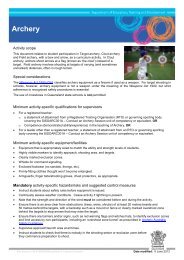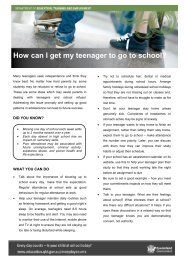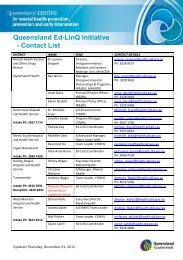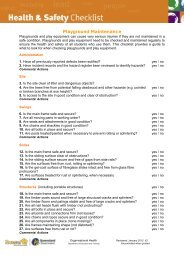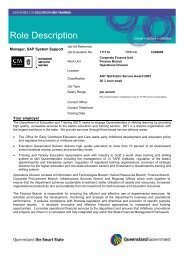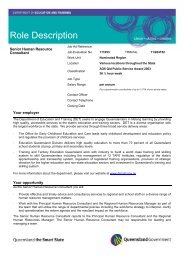1. What must be done to ensure electrical safety in schools? 2 ...
1. What must be done to ensure electrical safety in schools? 2 ...
1. What must be done to ensure electrical safety in schools? 2 ...
You also want an ePaper? Increase the reach of your titles
YUMPU automatically turns print PDFs into web optimized ePapers that Google loves.
How often <strong>must</strong> Safety Switches <strong>be</strong> tested?<br />
Noth<strong>in</strong>g is failsafe. Safety switches <strong>must</strong> <strong>be</strong> checked regularly <strong>be</strong>cause, just like a smoke detec<strong>to</strong>r or any<br />
other <strong>safety</strong> device, it can not protect you if it is not operat<strong>in</strong>g properly.<br />
All fixed and portable <strong>safety</strong> switches <strong>must</strong> <strong>be</strong> tested immediately after they are <strong>in</strong>stalled or connected<br />
There are two types of tests for your <strong>safety</strong> switch. For frequency of each ‘test’ please refer <strong>to</strong> the<br />
Part 1: Schedule or Part 2: Quick Reference Table of this guide:<br />
<strong>1.</strong> Regularly test<strong>in</strong>g your <strong>safety</strong> switch us<strong>in</strong>g the TEST but<strong>to</strong>n. This “user test” is <strong>done</strong> by someone at your<br />
school<br />
AND<br />
2. Test<strong>in</strong>g of the <strong>safety</strong> switch by a competent person. This is a time/current test performed by a competent<br />
person – it is necessary that an appropriately tra<strong>in</strong>ed and equipped person performs this test (e.g.<br />
electrician).<br />
How do I perform the regular “user” test<strong>in</strong>g of my <strong>safety</strong> switch us<strong>in</strong>g the TEST but<strong>to</strong>n?<br />
<strong>1.</strong> Note: some <strong>electrical</strong> equipment may malfunction (e.g. lose data, start or s<strong>to</strong>p unexpectedly) if the<br />
power supply is <strong>in</strong>terrupted. Consider this equipment when plann<strong>in</strong>g your tests e.g. you may need <strong>to</strong><br />
“shut down” computers <strong>be</strong>fore push<strong>in</strong>g the TEST but<strong>to</strong>n.<br />
2. Press the <strong>in</strong>built TEST but<strong>to</strong>n – this simulates a problem <strong>in</strong> the system.<br />
3. This should au<strong>to</strong>matically “engage”, “trip” or “operate” the <strong>safety</strong> switch and cause it <strong>to</strong> flick <strong>to</strong> the OFF<br />
position.<br />
4. Then simply press the RESET but<strong>to</strong>n.<br />
5. If press<strong>in</strong>g the TEST but<strong>to</strong>n does not cause the <strong>safety</strong> switch <strong>to</strong> flick <strong>to</strong> OFF then call an electrician<br />
immediately <strong>to</strong> have it checked. Seek advice from the electrician on the use of the <strong>electrical</strong> items <strong>in</strong> the<br />
<strong>in</strong>terim and note the advice. Higher risk items such as power <strong>to</strong>ols <strong>in</strong> <strong>in</strong>dustrial technology should not <strong>be</strong><br />
used until the switch is operat<strong>in</strong>g properly.<br />
6. Record the date of the test on a register.<br />
<strong>What</strong> do we do if the <strong>safety</strong> switch trips dur<strong>in</strong>g normal activities?<br />
<strong>1.</strong> If a <strong>safety</strong> switch trips and disconnects power, it may <strong>be</strong> due <strong>to</strong> a faulty appliance. You may have <strong>be</strong>en<br />
us<strong>in</strong>g a faulty appliance or your <strong>electrical</strong> wir<strong>in</strong>g may have <strong>be</strong>come faulty.<br />
2. Reset the <strong>safety</strong> switch by press<strong>in</strong>g the RESET but<strong>to</strong>n.<br />
3. If it trips aga<strong>in</strong>, unplug the last appliance used. If everyth<strong>in</strong>g works okay, la<strong>be</strong>l that item as faulty and<br />
arrange <strong>to</strong> have the item checked by an electrician.<br />
4. If the <strong>safety</strong> switch cont<strong>in</strong>ues <strong>to</strong> trip, disconnect all appliances on the circuit and plug them <strong>in</strong>, one at a<br />
time, until you locate the faulty one.<br />
5. Avoid <strong>to</strong>uch<strong>in</strong>g the appliances while carry<strong>in</strong>g out this process.<br />
6. Contact your electrician if problems persist.<br />
Safety switches are often confused with circuit breakers. Circuit breakers and fuses protect<br />
aga<strong>in</strong>st overload faults and high current short circuits. These do not replace <strong>safety</strong> switches.<br />
Safety switches protect people – circuit breakers protect equipment.<br />
Organisational Health Unit Novem<strong>be</strong>r 2008 13






